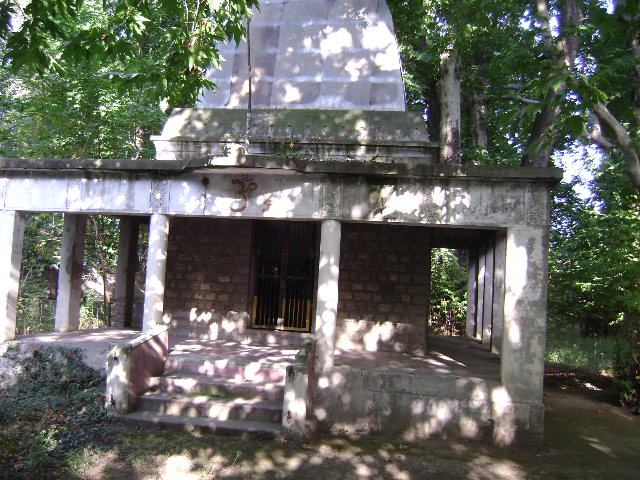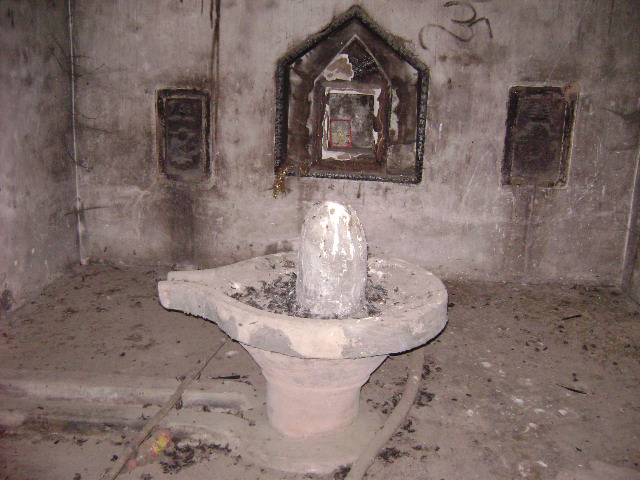Jagan Nath Bairav Temple
of Village Achan, Pulwama
by Chander Bhat
Achyan Cham Chyani maay mato
Har jaaye tsaran chus chyani tsay mato
Tatya lolike qunya zan dwar wathi
Katya rozi krardil mea by woy mato
Mai gachi ACHAN wuni achanachi joy mato
The worship of the village gods "Raza Sahib" is
most ancient form of the Indian religion. Before the Aryan invasion, which
probably took place in the second millennium B.C., the old inhabitants of India,
who are sometimes called Dravidians, were a dark-skinned race with religious
beliefs and customs that probably did not greatly differ from those of other
primitive race. They believed the world to be propled by a magnitude of
spirits, good and bad, which were the cause of all unusual events, and
especially of diseases and disasters.

Front view of Shri Jagan Nath Bairav Temple, Achan, Pulwama
This worship of the village Deity, or Raza
Sahib, as it is called in Kashmiri, forms an important part of the conglomerate
of religious beliefs, customs, and ceremonies which are generally classed
together under the term Hinduism. In almost evey village the Raza Sahib is
periodically worshipped and propitiated. Shiva and Vishnu may be more digified
beings, but the village deity is regarded as a more present help in trouble, and
is more intimately concerned with the happiness and prosperity of the villagers.
The origin of this form of Hinduism is lost in
antiquity but it is certain that it represents a pre Aryan cult of the Dravidian
people, more or less modified in various parts of North India by Brahmanical
influence; and some details of the ceremonies seem to point back to a totemistic
stage of religion. The normal function of the Raza Sahib is the guardianship of
the village, but many of them are believed to have other powers, especially in
relation to disease and calamity. The village deities and their worship are
widely different from the popular Hindu deities, Siva and Vishnu, and the
worship that centres in the great Hindu temples.

Shiv Lingam inside the burnt temple
Shiva and Vishnu represent forces of nature:
Shiva symbolizes the power of destruction and the idea of life through death,
Vishnu the power of preservation and the idea of salvation. Both these Gods and
the system of religion connected with them are the outcome of philosophic
reflection on the universe as a whole. But the village deities, on the other
hand, have no relation to the Universe. They are related, not to great world
forces, but to such simple facts as cholers, cattle disease etc.
The village deities are almost universally
worshipped with annual sacrifices and in Kashmir the same practice continued.
The sacrifice of lamb, in Kashmiri “Raza Kath” was offered to the village
deity or Raza Sahib when the wish made by a villager especially the Pandits was
fulfilled. The lamb so sacrificed was then cooked without any spices and
distributed amongst the villagers. When the lamb is sacrificed the blood of the
lamb is collected in an earthen pot called “Tok” in Kashmiri and the
blood is added to flour to make a paste and this paste is applied to the lid of
the pot in which the dish is prepared. All the parts of the lamb are prepared
including the legs etc. The member who has performed the sacrifice retains big
chunk of the dish.
There was a cremation ground situated at
Sheikhpora and was also the residing place of Raza Sahib of village Murran, one
of the brothers of Aasth Bairaves. The detail of the eight Bairaves with place
of residence is as follows:
-
Shri Jagan Nath - Village Achan
-
Shri Nandkisher - Village Sumbal
-
Shri Ganganand - Village Mattan
-
Shri Kakvishal - Village Pargachu
-
Shri Jeevan Nath - Village Ladhoo
-
Shri Moonglesher - Village Sirnoo
-
Shri Omkar Nath - Village Drussu
-
Shri Neilkanth - Village Murran
Bairav of village Achan, Shri Jagan Nath is the
eldest one and that of village Murran Shri Neilkanth is the youngest one. Shri
Keshev Nath was the grandfather of the Ashth Bairavas. Raza Sahib of Achan and
Sirnoo were vegetarian and rest were non-vegetarian.
Village Achan is in Pulwama and is 12 km away
from the district headquarter. Achan village has probably derived its name from
Sanskrit work Akhan meaning immortal. It may have been that village
contained unending capability or harvest and unending Santosh to the
people living there in. This Akhan must have stood to what it is currently known
by the name Achan. Village has its own history to explain. Its topographical
situation give it the distinction of getting maximum period of sunshine during
the day and thereby larger amount of solar energy to ignite life in this village
or magical coincidence with other adjoining villages.
There were some 30 Kashmiri Pandit families
living in Achan. 28 families have migrated to other parts of India during mass
exodus. Two families have held back despite all odds against them.
Image Gallery:
http://ikashmir.net/gallery/categories.php?cat_id=213
| 